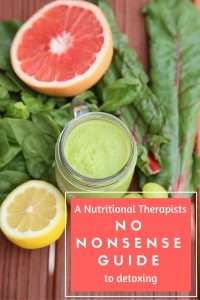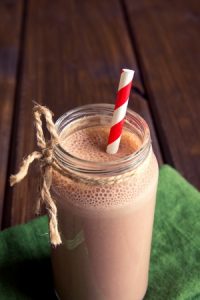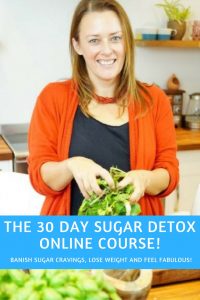 If there is one thing I know is going to come up again and again in January it’s detoxing.
If there is one thing I know is going to come up again and again in January it’s detoxing.
Is a detox on your list of New Year’s Resolutions?
Over the past few years detoxing has become a buzzword in the health and weight loss industry. ‘Detoxing’ juice drinks now come pre-mixed in the supermarket aisles, whilst thousands of man and women follow detoxing diets in a bid to become healthier, slimmer and stronger from within.
Problem is, with so much choice and conflicting information aboit, but how do you know whether the detox programme you pick is safe and will suit your body? In fact, how do you know you even need to do one in the first place?
As an experienced Nutritional Therapist and creator of the 30 Day Sugar Detox, I’ve run many detoxing progammes and workshops over the years, helping hundreds of clients in the process.
In this post I’m cutting through some of the nonsense about detoxes and giving you ideas on how to create a healthy, safe and effective detox that is perfect for putting the spring back into your step and helping you to shift the extra pounds you put on over Christmas.
Why do a detox?
Just like your house after a party, your cells can become sluggish and clogged with toxins and debris. This puts your liver under extra pressure as it works to clear the mess. The main purpose of a detox is to rid the body of these toxins by cutting the foods, drinks and habits that detoxify the body, things like smoking, alcohol, sugary drinks and processed foods and replacing them with vitamin-rich foods that support and nourish your liver, enabling it to process and eventually rid itself of excess toxins.
 Can detoxes be dangerous?
Can detoxes be dangerous?
A detox shouldn’t be dangerous, but if you have a pre-existing medical condition or are on any form of medication you should talk to your GP before beginning any kind of detox plan, even a very gentle one.
With any detox, you’ll probably experience a few side effects. But it’s important that a detox doesn’t make you feel awful for days or be so overly restrictive so that your blood sugar drops and your body struggles to cope. The downsides of a detox can be headaches, tiredness and even feeling slightly faint, a result of the raised levels of toxins in your bloodstream as your body begins to push them out.
I’ve seen many people go on strict detox programmes, only to find that when they start trying to re-introduce foods and eat normally (but still healthily) again, their digestive system find it difficult to keep up and they develop some uncomfortable symptoms. For this reason I always advise my clients to include some protein in their detox, rather than adopt a pure vegetable and fruit cleanse.
How to do a detox
Start by giving your diet a really good clean up. Processed, artificial and sugary foods, as well as alcohol, fizzy drinks and junk food are out!
Next, look at food groups which commonly cause digestive discomfort – gluten grains (wheat, rye, barley, spelt) and dairy products.
Most detoxes involve drinking plenty of freshly made juices and smoothies, to give your body a real boost of nutrients and support the liver – our bodies main detoxification organ.
Detoxing, liver friendly foods include:
- Apples
- Asparagus
- Beets
- Broccoli
- Carrots
- Dark Green Cabbage
- Garlic
- Ginger
- Grape Fruit
- Green Tea
- Kale
- Lemons
- Onions
- Pineapple
 If your digestive system is sluggish, remember this is one of the main channels through which your body gets rid of toxins… in your stools.
If your digestive system is sluggish, remember this is one of the main channels through which your body gets rid of toxins… in your stools.
If you struggle to go to the toilet, speak to a professional such as myself about how to get your system going, or try some natural products such as probiotics, psyllium husks or lepicol.
Of course a good detox isn’t just about what you put into your body… Don’t forget that your skin is a major detoxification site: think carefully about the things you put on it. Choose only natural, unprocessed ingredients (I like brands such as Faith in Nature, Hopes, Bentley, Green People and Weleda.)
You can also help the detox process by making sure all your cleaning products are as natural as possible, as these can be a major source of toxins and chemicals that need to be processed by your liver.
Pregnant women and breastfeeding mothers beware
Most environmental toxins are fat-soluble, which means that they are stored in our fat cells. During a detox, these toxins are released into the bloodstream where they are carried to the liver and filtered out of the body. For this reason if you are pregnant or breast-feeding you should avoid doing a detox as these toxins could be passed from mother to baby as blood passes through the placenta or through breast tissue.
 The 30 Day Sugar Detox Online Programme
The 30 Day Sugar Detox Online Programme
If you’re looking for a safe and really effective detox this January, why not join my 30 Day Sugar Detox online programme? It packs months of nutritional coaching into seven easy-to-follow modules and can help you shake off your sugar cravings, once and for all!
The 30 Day Sugar Detox ecourse includes videos, meal planners, shopping lists, recipes, top tips and a free copy of my popular ebook: Junk Food to Super Food. You’ll also get exclusive access to my Secret 30 Day Sugar Detox Facebook Group, where I’ll be online every week to answer any questions and help keep you on track.
>> Ready to quit sugar for good? Discover the 30 Day Sugar Detox here.